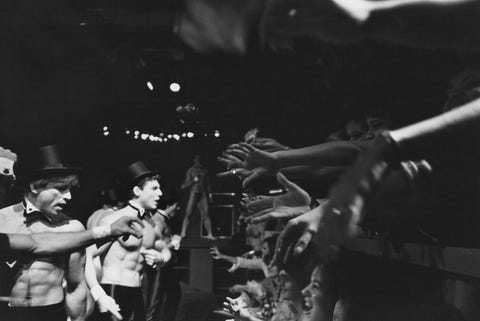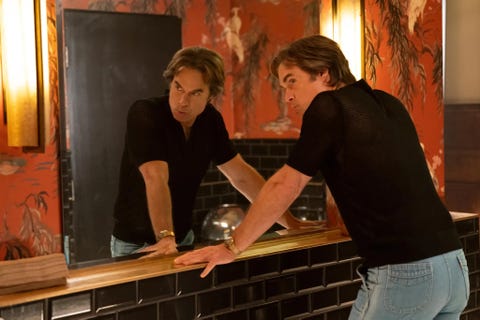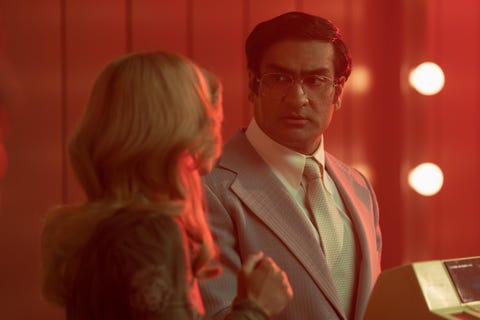You may have already seen ads for Welcome to Chippendales, the new Hulu true-crime miniseries, which is one of the streamer’s bigger offerings of the year and perhaps its splashiest effort since the Emmy-nominated Pam & Tommy earlier in the year. In fact, the eight-episode Welcome to Chippendales (now streaming) comes from Pam & Tommy creator Robert Siegel, with an opening episode directed by Matt Shakman of WandaVision.
In another ripped-from-real-life, lurid celebrity tale, Siegel’s Welcome to Chippendales covers the behind-the-scenes scheming involved in the rise of the famous (or infamous) Chippendales, the cheesy all-male striptease show. (The show is adapted from the book Deadly Dance: The Chippendales Murders by K. Scot Macdonald and Patrick MontesDeOca.)
Kumail Nanjiani stars as (real) Chippendales founder Somen “Steve” Banerjee, who starts Episode 1 as an Indian American gas station manager and transforms into Steve, the nightclub owner with the then-novel, effective idea of putting on an all-male revue for a female audience in 1979. As the Hulu series goes along, it digs into the bitter rivalry between Steve and his choreographer Nick De Noia, played by White Lotus Emmy-winner Murray Bartlett. The cast also includes Annaleigh Ashford, Juliette Lewis, Quentin Plair, Robin de Jesús, and Andrew Rannells.
Just the word “Chippendales” has become synonymous with male stripping. But if you didn’t know about the origin story behind the nightclub, and the bloody consequences, you’re far from alone. Here’s an explainer on the true story that fuels the glamor, excess, and vengeance in Hulu’s Welcome to Chippendales.
How Somen ‘Steve’ Banerjee Started Chippendales
The 1980s-set Welcome to Chippendales spans the early years of the original nightclub in West Los Angeles (not Las Vegas as you might fairly assume), which was launched by Somen “Steve” Banerjee: its meteoric rise, and dramatic fall. Steve, as he became known, was born in India in 1946 before moving to the United States. (He died in L.A. in 1994, but more on that later.) Part of the draw of Welcome to Chippendales is watching things unfold from the perspective of an immigrant hustling to attain the American Dream—or his version of it, anyway.
“What resonated with me most about [Steve Banerjee] was that he’s the king of a world that would not have him unless he was the king,” Nanjiani told Women’s Wear Daily of making Welcome to Chippendales and its inspiration. “I saw a picture of him with the Chippendale dancers, and it’s like this pudgy, brown, bespectacled nerd with all these white Adonises. He feels like he doesn’t fit in this club.”
But Steve indeed found acceptance, and success and tons of money, with his male revue named after (yes) a furniture brand. With help developing the concept from promoter Paul Snider (guest star Dan Stevens), Steve made Chippendales a known entity. Male performers wore a signature uniform of bow ties, cuffs, and spandex pants modeled off the bunny-eared Playboy Bunnies, according to The Daily Beast’s reporting.
Meanwhile, the vision of Chippendales choreographer Nick De Noia (Bartlett) turned out to be pivotal to the club’s success. But relations between Steve and Nick soured, and when Nick broke out on his own and found a legal maneuver to run tour engagements under the Chippendales name, Steve felt betrayed and sought retribution against his former colleague.
Inside the Chippendale Murders and Steve Banerjee’s Arrest
Well, Steve Banerjee seemed to embrace all the wrong lessons from past American moguls. And his path to glory, or annihilation, got messy.
Here’s what happened: At 46, the choreographer Nick was shot to death by an unknown assailant in his office in New York City’s garment district in 1987, according to The New York Times reporting from the time. A bullet from a large-caliber handgun pierced his left cheek.
The truth behind the bloody scene only became clear years later: In July 1994, Steve pleaded guilty to arranging the murder of Nick, along with a racketeering charge connected to attempted arson at a restaurant in LA’s Marina del Rey. According to The Los Angeles Times, Steve and another unknown man had paid the gunman an undisclosed sum to kill Nick, whom Steve perceived as a threat to his empire. Per the extensive federal investigation into the Chippendales-related crimes, Steve had also allegedly orchestrated to kill three former Chippendales associates who had left for a competing male dance revue, but those men survived.
Steve ultimately wouldn’t face justice for his gruesome acts: Following his guilty plea for the murder-for-hire, in October 1994, the Chippendales owner committed suicide in a Downtown L.A. jail cell, the L.A. Times reported. He was awaiting sentencing for the murder of Nick, his onetime business partner.
How is Welcome to Chippendales as a show?
At least in the early episodes, Welcome to Chippendales moves along smoothly enough, with sumptuous cinematography and a credible budget to pull off its retro sleaze and glitz. The acting, from Nanjiani to the supporting players, hits the right marks. The angle on the material can, however, feel anonymous, as if the show itself doesn’t know what to make of the story. The screenplay gears turn a little too obviously. Then again, there are many, many wild facts to incorporate. Welcome to Chippendales indulges perhaps too much explanation of the ‘80s post-women’s liberation movement context. (Playboy Playmate Dorothy Stratten, played by guest star Nicola Peltz, rattles off, “Erica Jong, Deep Throat, the Pill,” summing things up for the viewer.)
It’s also hard not to feel the influence of, say, the 1998 Ryan Phillippe-starring 54 about the similarly seedy rise and fall of Studio 54. There are echoes of HBO Max’s Minx, this year’s charming-if-slight exploration of a fictional male pinup magazine (in the vein of Playgirl) set in 1970s Los Angeles. Like that show, Welcome to Chippendales seems to exist mostly due to a surplus of based-on-a-true-story television these days, and the fact that it involves crime and bare male ass cheeks. Welcome to Chippendales has juicy TV written all over it, even if the actual show could be a little more gripping.
Paul Schrodt is a freelance writer and editor who also contributes to Esquire, GQ, Money, The Wall Street Journal, and more.














